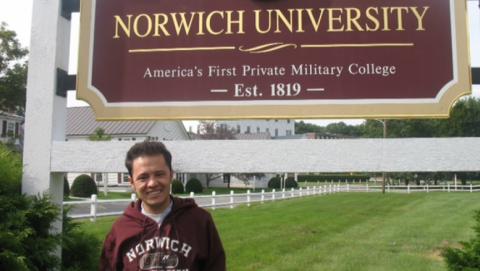TRANSCRIPT
I never imagined that ordering lunch in the US would be an ordeal for me. Back in Afghanistan, I taught English for several years. I watched countless Hollywood movies, and worked with foreigners for almost four years. I performed well on standardized tests of English, or at least in English, like the TOEFL exam and the SATs.
So I never expected that bread, cheese or a drink would challenge my English abilities.
The day I arrived in the US, my plane was diverted to Raleigh-Durham Airport in North Carolina. While waiting for my next flight, I went to one of the cafeterias close to my gate. People were lined up, so I went to the end of the line. It was crowded and the staff was working hurriedly. Since I had no idea what cuisines they served, I decided to order just a sandwich.
I thought that's the simplest, easiest and fastest food to get. It was my turn to place my order. I asked the lady for a chicken sandwich. She asked,
"What do you want it on?" I stared at her quizzically and was speechless for a moment.
The lady asked louder, "What bun do you want?"
I said, "Just a chicken sandwich please."
The lady replied impatiently, "Yes, I know. But what bun?"
I didn't know what to say. I couldn't understand her. Then I thought maybe she was asking about the sauce.
"Hmmm, it doesn't matter," I responded.
She seemed irritated, and then asked rapidly, "Cheddar, pepper jack, Swiss, provolone, or American?"
This is what I heard: "Chedie, paper jack, Swiss (the country), provolo, or American (also, the country)?"
I wondered, "Are they different types of chicken? Does chicken differ from one country to another?" I stared at her mutely as my brain tried to decipher the meaning of those words.
Starting to sweat, I acted as if I didn't understand English at all. Then I said, "American please!" Maybe because that was the last option and the easiest to remember.
Then she asked, "Fountain drink or bottled soda?" I just wanted to cancel my order and stay hungry instead of standing in front of this hasty waitress who seemed frustrated by me and whose offers I couldn't understand at all.
My anxiety mounted in this crowded line of hungry customers who were all waiting for me to finish my order, and I, I just didn't know what to say. I said, "I just want a soft drink. That's it ma'am."
She said, "I know, but bottled or fountain?" That was more pressure than the TOEFL exam. I never imagined that buying a sandwich in the US would be this challenging and cause me so much embarrassment.
The $100 bill in my hand was damp with my sweat, squeezed and crumpled. "Bottled please," I said, although I had no idea what the difference was.
When I paid for my food, I stood in my place expecting my food to be delivered to the counter instantly. The lady said, "Sir, this is your slip. Please take a seat and we will call you when your food is ready."
I nodded like a parrot who understands everything people tell him and walked away. But now I wondered how she would call me. While sitting at my table, I watched and listened vigilantly. I realized she was calling customers by number. I stared at the number on my slip and listened intently. When I heard my number, I took my food and found a seat far away from the cafeteria.
As I ate my first meal in the US, I pondered over the fact that I knew words like abrogate, conflagration and inexorable, but not the words "bun" or "fountain drink." I could comfortably write professional technical proposals and review solicitations in English, but I broke into a sweat ordering a chicken sandwich.
And then I realized my lunch ordeal wasn't an English deficiency, but a cultural difference. I had just arrived from a country with very few options: bread is bread and cheese is cheese. And if we're lucky enough to have any choices, it’s usually the choice between yes or no.






